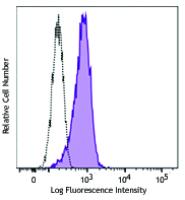-
Sign In
-

-
 Sony Biotechnology
Sony Biotechnology
-

-
 Sony Biotechnology
Sony Biotechnology
PerCP/Cy5.5 anti-GFP
Antibodies Single
Sony
FM264G
Flow Cytometry
Rat IgG2a, κ
Human
TLR9-GFP transfected cell line
25 tests
2290055
$185.00
Description
Green fluorescent protein (GFP) was originally identified as a protein involved in bioluminescence, which is from the jellyfish Aequorea Victoria. It is widely used as a fluorescent indicator for monitoring gene expression in a variety of cellular systems, including living organisms and fixed tissues. Unlike other bioluminescent reporters, GFP fluoresces without the need for exogenous substrates or cofactors, or other intrinsic or extrinsic proteins, making GFP a useful tool for monitoring gene expression and protein localization in vivo. Purified GFP is a 27 kD monomer consisting of 238 amino acids and emits green light (emission maximum at 509 nm) when excited with blue or UV light.
Formulation
Phosphate-buffered solution, pH 7.2, containing 0.09% sodium azide and 0.2% (w/v) BSA (origin USA).Recommended Usage
Each lot of this antibody is quality control tested by intracellular immunofluorescent staining with flow cytometric analysis. For flow cytometric staining, the suggested use of this reagent is 5 microL per million cells or 5 microL per 100 microL of whole blood. It is recommended that the reagent be titrated for optimal performance for each application.
* PerCP/Cy5.5 has a maximum absorption of 482 nm and a maximum emission of 690 nm.
This product is subject to proprietary rights of Sirigen Inc. and is made and sold under license from Sirigen Inc. The purchase of this product conveys to the buyer a non-transferable right to use the purchased product for research purposes only. This product may not be resold or incorporated in any manner into another product for resale. Any use for therapeutics or diagnostics is strictly prohibited. This product is covered by U.S. Patent(s), pending patent applications and foreign equivalents.


